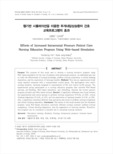

PARTNER
검증된 파트너 제휴사 자료
웹기반 시뮬레이션을 이용한 두개내압상승환자 간호 교육프로그램의 효과 (Effects of Increased Intracranial Pressure Patient Care Nursing Education Program Using Web-based Simulation)
15 페이지
최초등록일 2025.03.14
최종저작일
2023.12

-
서지정보
· 발행기관 : 한국간호시뮬레이션학회
· 수록지 정보 : 한국간호시뮬레이션학회지 / 11권 / 2호 / 1 ~ 15페이지
· 저자명 : 김원정, 강숙정
초록
Purpose: The purpose of this study was to develop a nursing education program using Web-based simulation for the care of patients with intracranial pressure. An additional aim was to verify the effectiveness of nursing knowledge, problem-solving competency, a critical thinking disposition, and the expectation of learning transfer. Methods: This was an experimental study using repeated measures with a nonequivalent control group. The participants were senior nursing students, randomly assigned to experimental (n=30) and control (n=30) groups. The experimental group participated in a nursing education program that included Web-based lectures, pre-briefing, Web-based simulation, and debriefing, whereas the control group’s program included only Web-based lectures. Results: A significant difference was found between the experimental and control groups in problem-solving competency (F=5.84, p=.005), critical thinking disposition (F=4.25, p=.021), and the expectation of learning transfer (t=2.30, p<.025).
Also, a significant interaction between time and group was found in problem-solving competency and critical thinking disposition. Conclusion: The results of this study showed that the education program using Web-based simulation positively affected nursing students’ problem-solving competency, critical thinking disposition, and the expectation of learning transfer. Therefore, this program can be considered a valuable aid in educating nursing students.영어초록
Purpose: The purpose of this study was to develop a nursing education program using Web-based simulation for the care of patients with intracranial pressure. An additional aim was to verify the effectiveness of nursing knowledge, problem-solving competency, a critical thinking disposition, and the expectation of learning transfer. Methods: This was an experimental study using repeated measures with a nonequivalent control group. The participants were senior nursing students, randomly assigned to experimental (n=30) and control (n=30) groups. The experimental group participated in a nursing education program that included Web-based lectures, pre-briefing, Web-based simulation, and debriefing, whereas the control group’s program included only Web-based lectures. Results: A significant difference was found between the experimental and control groups in problem-solving competency (F=5.84, p=.005), critical thinking disposition (F=4.25, p=.021), and the expectation of learning transfer (t=2.30, p<.025).
Also, a significant interaction between time and group was found in problem-solving competency and critical thinking disposition. Conclusion: The results of this study showed that the education program using Web-based simulation positively affected nursing students’ problem-solving competency, critical thinking disposition, and the expectation of learning transfer. Therefore, this program can be considered a valuable aid in educating nursing students.참고자료
· 없음태그
-
자료후기
-
자주묻는질문의 답변을 확인해 주세요

꼭 알아주세요
-
자료의 정보 및 내용의 진실성에 대하여 해피캠퍼스는 보증하지 않으며, 해당 정보 및 게시물 저작권과 기타 법적 책임은 자료 등록자에게 있습니다.
자료 및 게시물 내용의 불법적 이용, 무단 전재∙배포는 금지되어 있습니다.
저작권침해, 명예훼손 등 분쟁 요소 발견 시 고객센터의 저작권침해 신고센터를 이용해 주시기 바랍니다. -
해피캠퍼스는 구매자와 판매자 모두가 만족하는 서비스가 되도록 노력하고 있으며, 아래의 4가지 자료환불 조건을 꼭 확인해주시기 바랍니다.
파일오류 중복자료 저작권 없음 설명과 실제 내용 불일치 파일의 다운로드가 제대로 되지 않거나 파일형식에 맞는 프로그램으로 정상 작동하지 않는 경우 다른 자료와 70% 이상 내용이 일치하는 경우 (중복임을 확인할 수 있는 근거 필요함) 인터넷의 다른 사이트, 연구기관, 학교, 서적 등의 자료를 도용한 경우 자료의 설명과 실제 자료의 내용이 일치하지 않는 경우
찾으시던 자료가 아닌가요?
지금 보는 자료와 연관되어 있어요!
문서 초안을 생성해주는 EasyAI



